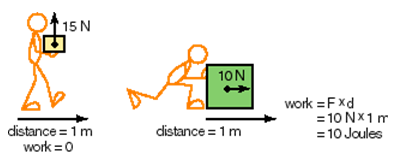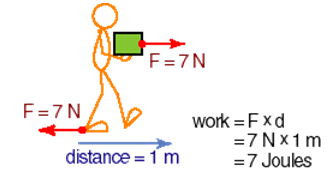What is Work
Everyone knows what work is, right? It is anything you would rather not do, like take out the trash, or study for a test. Well, not quite. In everyday language this definition might work OK but to solve physics problems and predict what will happen in given situations, we need a more specialized definition. In physics, work is done when a force is exerted through a distance.
For example, if I push you in your chair and I move you one meter from where you are now, I have done work. I have applied a force (how hard I have to push to scoot you and your chair) over a distance (how far you moved) of one meter. If I try to push a car and I cannot move it, I have done no work. There was a force, how hard I pushed, but no distance, because the car did not move.
Using F for the force in Newtons, d for the distance in meters and W for the work in joules, this can be shortened to:
W = F x d
Where force and distance must be in the same direction.
Example: If I lift a quarter pound hamburger with cheese with a force of one Newton up a distance of one meter, how much work have I done?
Work = Force x distance
= 1 Newton x 1 meter
= 1 Newton - meter
= 1 joule
I did one joule of work.
This specialized definition of work makes some situations, in which you might naturally think, “Of course work is being done,” ones in which no work is done.

What if you are carrying your books over level ground from one place to another? You might think - I am exerting a force,(15 N) using my muscles to hold up my books and I am moving a distance (1 meter) from one place to another, so I have done work. Why not? The force holding up the books and the distance across the ground are not in the same direction.
How about if I pushed the books along the ground from one place to another? Yes now, the force, a push along the ground (10 N) and the distance along the ground (1 meter) are in the same direction so work (10 joules) has been done.
In the first example, I just picked the wrong force to consider. If I look at the force (7 N) my feet push against the ground which is equal to the force moving me and my books forward, and the distance forward (1 meter), I would be able to see the work ( 7 joules) being done.
What if you are reading a book? Are you doing work? No, if you look at you and the book. During the process of reading, neither gain energy so no useful work was done. But, yes, if you look at turning the pages, you are lifting the page with a force and it moves up so work is done on the page. It is a simple idea, but it takes a bit of practice and thought to be able to pick out the appropriate forces and distances. But go on and read ahead to see what this is good for!
